Changes in passive tension of muscle in humans and animals after eccentric exercise
- PMID: 11389215
- PMCID: PMC2278643
- DOI: 10.1111/j.1469-7793.2001.0593a.x
Changes in passive tension of muscle in humans and animals after eccentric exercise
Erratum in
- J Physiol 2001 Aug 1;534(Pt 3):935
Abstract
1. This is a report of experiments on ankle extensor muscles of human subjects and a parallel series on the medial gastrocnemius of the anaesthetised cat, investigating the origin of the rise in passive tension after a period of eccentric exercise. 2. Subjects exercised their triceps surae of one leg eccentrically by walking backwards on an inclined, forward-moving treadmill. Concentric exercise required walking forwards on a backwards-moving treadmill. For all subjects the other leg acted as a control. 3. Immediately after both eccentric and concentric exercise there was a significant drop in peak active torque, but only after eccentric exercise was this accompanied by a shift in optimum angle for torque generation and a rise in passive torque. In the eccentrically exercised group some swelling and soreness developed but not until 24 h post-exercise. 4. In the animal experiments the contracting muscle was stretched by 6 mm at 50 mm s(-1) over a length range symmetrical about the optimum length for tension generation. Measurements of passive tension were made before and after the eccentric contractions, using small stretches to a range of muscle lengths, or with large stretches covering the full physiological range. 5. After 150 eccentric contractions, passive tension was significantly elevated over most of the range of lengths. Measurements of work absorption during stretch-release cycles showed significant increases after the contractions. 6. It is suggested that the rise in passive tension in both human and animal muscles after eccentric contractions is the result of development of injury contractures in damaged muscle fibres.
Figures
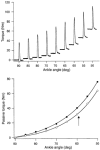
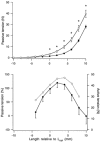
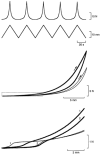
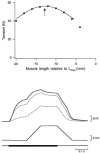

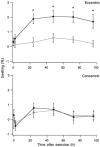

Similar articles
-
Changes in the mechanical properties of human and amphibian muscle after eccentric exercise.Eur J Appl Physiol Occup Physiol. 1997;76(1):21-31. doi: 10.1007/s004210050208. Eur J Appl Physiol Occup Physiol. 1997. PMID: 9243166
-
Rises in whole muscle passive tension of mammalian muscle after eccentric contractions at different lengths.J Appl Physiol (1985). 2003 Sep;95(3):1224-34. doi: 10.1152/japplphysiol.00163.2003. Epub 2003 May 9. J Appl Physiol (1985). 2003. PMID: 12740312
-
Tendon organs as monitors of muscle damage from eccentric contractions.Exp Brain Res. 2003 Aug;151(3):346-55. doi: 10.1007/s00221-003-1508-3. Epub 2003 Jun 19. Exp Brain Res. 2003. PMID: 12819844
-
Muscle damage from eccentric exercise: mechanism, mechanical signs, adaptation and clinical applications.J Physiol. 2001 Dec 1;537(Pt 2):333-45. doi: 10.1111/j.1469-7793.2001.00333.x. J Physiol. 2001. PMID: 11731568 Free PMC article. Review.
-
Damage to skeletal muscle from eccentric exercise.Exerc Sport Sci Rev. 2005 Apr;33(2):98-104. doi: 10.1097/00003677-200504000-00007. Exerc Sport Sci Rev. 2005. PMID: 15821431 Review.
Cited by
-
Acute muscle and joint mechanical responses following a high-intensity stretching protocol.Eur J Appl Physiol. 2016 Aug;116(8):1519-26. doi: 10.1007/s00421-016-3410-2. Epub 2016 Jun 7. Eur J Appl Physiol. 2016. PMID: 27270900 Clinical Trial.
-
Pathways of Ca²⁺ entry and cytoskeletal damage following eccentric contractions in mouse skeletal muscle.J Appl Physiol (1985). 2012 Jun;112(12):2077-86. doi: 10.1152/japplphysiol.00770.2011. Epub 2012 Mar 29. J Appl Physiol (1985). 2012. PMID: 22461447 Free PMC article.
-
Repeated maximal eccentric actions causes long-lasting disturbances in movement control.Eur J Appl Physiol. 2005 May;94(1-2):62-9. doi: 10.1007/s00421-004-1253-8. Epub 2004 Dec 18. Eur J Appl Physiol. 2005. PMID: 15609028 Clinical Trial.
-
Muscle Shear Elastic Modulus Provides an Indication of the Protection Conferred by the Repeated Bout Effect.Front Physiol. 2022 Apr 29;13:877485. doi: 10.3389/fphys.2022.877485. eCollection 2022. Front Physiol. 2022. PMID: 35574495 Free PMC article.
-
Posterior shoulder stiffness was associated with shoulder pain during throwing in college baseball players: assessment of shear wave elastography.Eur J Orthop Surg Traumatol. 2023 May;33(4):1237-1244. doi: 10.1007/s00590-022-03286-z. Epub 2022 May 18. Eur J Orthop Surg Traumatol. 2023. PMID: 35583565
References
-
- Armstrong RB, Warren GL, Warren JA. Mechanisms of exercise-induced muscle fibre injury. Sports Medicine. 1991;12:184–207. - PubMed
-
- Brockett C, Morgan DL, Proske U. Human hamstring muscles adapt to damage from eccentric exercise by changing optimum length. Medicine and Science in Sports and Exercise. 2001;33:783–790. - PubMed
-
- Brockett C, Warren N, Gregory JE, Morgan DL, Proske U. A comparison of the effects of concentric versus eccentric exercise on force and position sense at the human elbow joint. Brain Research. 1997;771:251–258. - PubMed
-
- Burke RE, Levine DN, Zajac FE. Mammalian motor units: physiological-histochemical correlation in three types in cat gastrocnemius. Science. 1971;174:709–712. - PubMed
MeSH terms
LinkOut - more resources
Full Text Sources
Other Literature Sources
Medical
Miscellaneous

